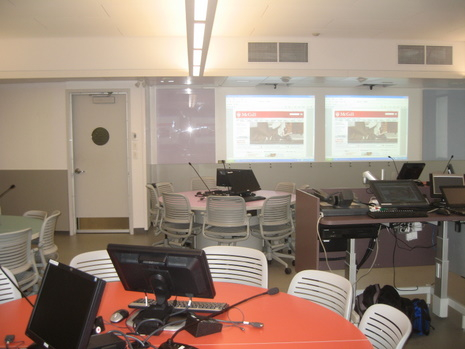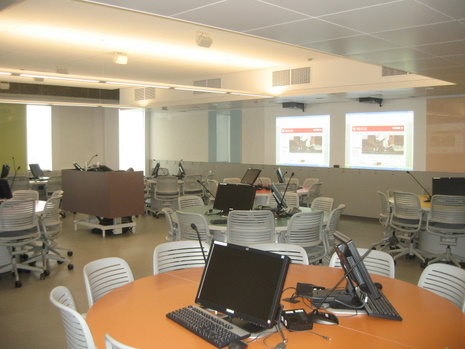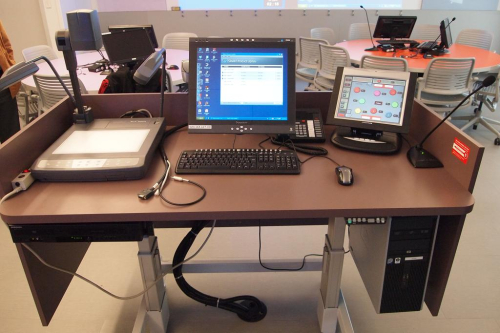- Location: 3700 rue McTavish, Montreal, QC
- Capacity: 72 students
- Type: Active learning classroom
Alignment with principles for designing Teaching and Learning Spaces
Academic challenge
Promote individual, active engagement with content.
Layout
Work surfaces for notebooks, laptops, and textbooks: large, shared tables.
Acoustics: Acoustically treated doors and windows to avoid distraction.
Furniture
Comfortable furniture: adjustable, ergonomically approved chairs.
Technologies
Access to infrastructure: power for student laptops, networked printing, desktop computers available. Access to resources: LMS, internet (via laptops or available desktops).
Lighting & colour
Appropriate lighting for individual work. Intentional use of color to promote focus.

Learning with peers
Promote active engagement with one another.
Layout
Promote face-to-face communication: round tables encourage students to communicate with one another in groups of up to 9. Individuals can move about easily, and sight lines are unobstructed.
Acoustics: Sound zones support multiple simultaneous conversations at student tables. Appropriate amplification available (student table mics, carefully placed speakers).
Furniture
Flexible seating (chairs on wheels).
Technologies
Shared workspaces (writable walls, screen-sharing).
Lighting & colour
Different lighting patterns support different activities. Writable wall board colours match table colours to define the collaborative brainstorm space for each group.

Experiences with faculty
Promote interaction and communication.
Layout
Easy access to all students: Instructor is in middle of room and can circulate easily from table to table.
Acoustics: Sound zones support multiple simultaneous conversations. Wireless and wired audio amplification available.
Furniture
djustable-height podium doesn't interfere with sightlines, movement and interaction, and has ample surface space for instructional materials. Mobile chairs support different teaching strategies (e.g., group work in various sizes, student presentations, etc).
Technologies
Dual-source projection and multiple classroom technology sources (Sympodium, document camera, student computers, etc.) and multiple screens permit simultaneous display of different learning materials. Instructor can control classroom technologies away from the podium via wireless mouse.
Lighting & colour
Different lighting patterns support multiple types of teaching tasks. Colours distinguish what groups work on which writable wall boards.

Contributions to the campus environment
Classrooms that incorporate elements of active and collaborative learning are part of a vision for a variety of flexible campus learning spaces. This room is designed for all populations using the space: well-lit, with a standardized room control panel that simplifies instructors’ use of equipment in classrooms across campus. IT is consistent with teaching and learning needs, and durable furniture contributes to sustainability efforts. Both physical and virtual affordances help maximize High Impact Practices (HIPs) for student learning within and beyond this classroom.
